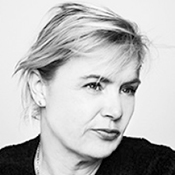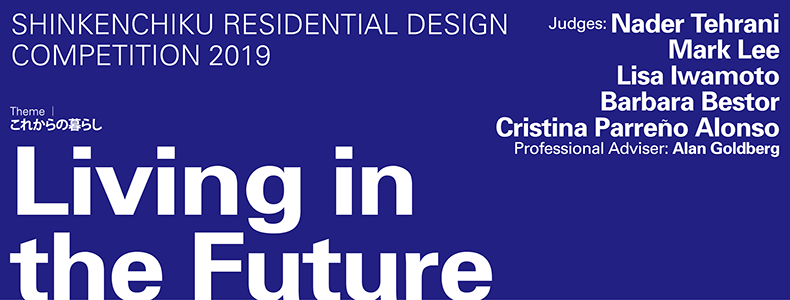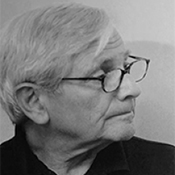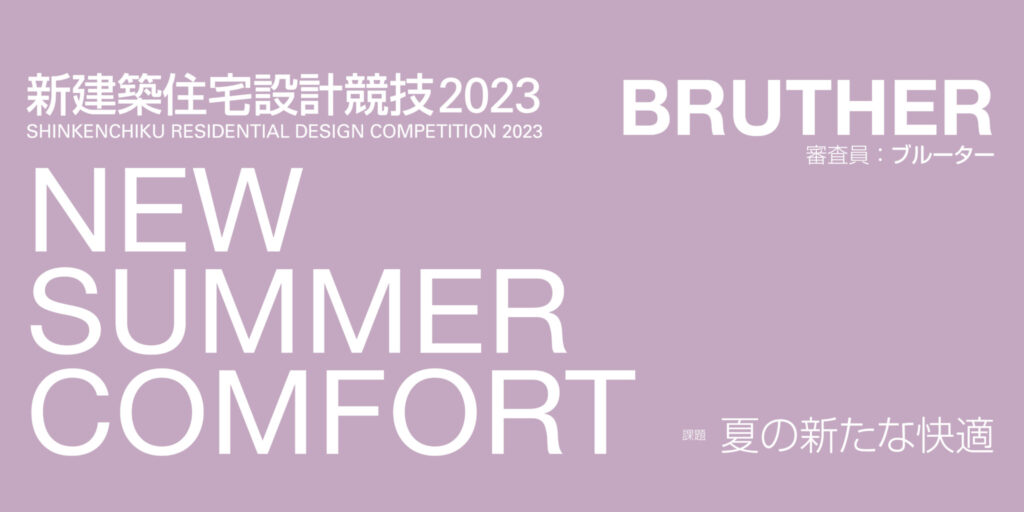Shinkenchiku Residential Design Competition 2019 Life in the Future
Theme Life in the Future
What will the future look like? How can architects design dwellings to meet evolving living patterns and the challenges of the future? This competition offers the contestant the opportunity to answer these questions. The contestant will be asked to design dwellings that take a bold social and environmentally sustainable view of the future.
70 years ago, New Canaan’s Mid Century architects faced similar questions. To these architects who practiced during that period, Mid-Century Modern was more than a style. It was a social, and even a political movement. They believed that the architecture they practiced offered new ideas for living that were more advanced and better suited for the times than the architecture that preceded them. By creating more efficient and scientific households, they thought of houses as “Machines for Living,” a term that became popular at the time. (a+u 19:05)
Now, more than 70 years later, it is time to re-examine the criteria on which the success of housing is formed, both from a programming, architectural and urbanistic point of view. In order to look to the future, one must not only understand the successes and failures of the past, but also be able to gauge what are some of the urgencies of the present.
Alan Goldberg
Note: There is an additional announcement about submission requirements from Alan Goldberg, the professional advisor.
1. Write a 300 word essay in English, or 600 characters in Japanese, which must be in 12 point type or larger, describing the physical and social challenges that will be faced by people living in the future, and how you would address these challenges.
2. The judging criteria will be based on how successfully the applicants' submission meet the challenges they identify.
a. Efficient use of land
b. Use of latest building technologies
c. Lowering resource consumption
d. Affordability
e. Social benefits
Prize
- WinnerMultiple1,000,000¥
The number of winners and the amount of prize will be determined by the judges.
Schedule
- 2019.05.01 (水)Registration opens
- 2019.09.30 (月)Registration closed
- 2019.01.01 (火)Announcement of the Winner
Guidelines
Entry and Application
To enter the competition, please first register on the competition website. A registration number will be issued by email after the registration form is properly completed. Each applicant should keep a record of this registration number, as it will be needed for submitting your proposal. If there is any change in the registered personal information, re-registration is required. Also, if the applicant wishes to submit multiple proposals, it is necessary to obtain a registration number for each proposal.
• No inquiries regarding the registration number will be accepted once the number has been issued.
• Registration is only available through the competition website.
• Use of mobile phone email address is not recommended since there might be problems in receiving the registration number.Submission Requirements
Contents: Site plan, floor plan, elevation, section, perspective drawing and axonometric drawing at any scale. You are free to include photograph of a model, detailed drawing, other chart. Your submission should include a descriptive text of your design in less than 250 words in English, which must be in 12 point type or larger. Paste this same text in your submission email. All drawings, illustrations, and texts should be laid out on two sheets of A2 (420×594 mm / 16.5×23.5 inches).
• File format: PDF
• File size should not exceed 10 MB (please combine two sheets in one file)
• The registration number must be used as the name of the PDF file of each design entry (e.g., skc0000.pdf).Submission Procedure
Use your pre-registered email address and adhere to the format described below.
1) Email subject line should read: “0000 (your registration number) / Shinkenchiku Residential Design Competition 2019”.
2) Attach your submission file. Be mindful of the file size. Files that do not meet the specified requirements will not be considered.
3) Your email should include the following information: the registration number / full name, age, and profession of all the team members / team leader’s home address, telephone number, fax number (if available), and email address / a descriptive text of the design in less than 250 words.
Note: The amount of emails right before the deadline may overwhelm our internet server, so please do not wait until the last minute to submit your entry. The competition hosts will take no responsibility for submissions that arrive late due to technical issues and will not judge such submissions.Announcement of the Winner
Winner(s) will be announced in the 2020 January issue of SHINKENCHIKU (published on Jan 1, 2019) and a+u (published on Dec 27, 2019) magazines, their digital issues and on the competition website.
Notice
• Copyright of the proposal belongs to the applicant, while the publishing right belongs to Shinkenchiku-sha Co., Ltd..
• Submitted proposals, regardless of the result, may be published on the competition website.
• Questions regarding the competition regulations will not be answered by the hosts. All matters not covered in the regulations listed above are left to the discretion of the entrants.
• Proposals must not have been made public previously in any form. The work must not (in total or in part) infringe on anybody’s copyrights. Do not use images copied from magazines, books, or websites. If a copyright infringement is discovered, the prize may be taken back at the host’s discretion.
• The winning entrants will be requested to submit high-resolution digital data for publication.
• All fees associated with submissions must be borne by entrants.
• Please double-check the contents of your submission. You will not be allowed to replace your proposal after submission.
• Please avoid corrupted texts and broken links. Please embed all the linked files.
• Entries will only be accepted if they adhere to all the regulations.
Judges
Christoph IngenhovengJury Chair
Dean of the Irwin S. Chanin School of Architecture at The Cooper Union and Principal at NADAAA, a practice dedicated to the advancement of design innovation, interdisciplinary collaboration, and an intensive dialogue with the construction industry. His work has been recognized with notable international awards in architecture. Photo by Leo Sorel, courtesy The Cooper Union.
Mark LeeJury Member
Founding partners of the architecture firm Johnston Marklee & Associates, and Chairman of Department of Architecture at the Graduate School of Design at Harvard University. He was the co-curator of the 2017 Chicago Architecture Biennial ‘Make New History’.
Lisa IwamotoJury Member
Founding Partner of IwamotoScott Architecture which she leads with her partner Craig Scott. Lisa received her Master of Architecture degree with Distinction from Harvard University, and a Bachelor of Science degree in Structural Engineering from the University of Colorado. She is a Professor at the University of California Berkeley.
Barbara BestorJury Member
Founding principal of Bestor Architecture. Since 1995, She has actively redefined Los Angeles architecture with a practice that engages the city through design, art, and urbanism. She received her undergraduate degree at Harvard University, studied at the Architecture Association in London and received a MARCH at SCI-Arc.
Cristina Parreño AlonsoJury Member
Licensed architect who specializes in activating public spaces through architecture and art installations. Cristina has taught design studios at the State University of NY at Buffalo and Harvard GSD. She currently teaches graduate and undergraduate design studios at MIT School of Architecture and Planning.
Alan GoldbergProfessional Advisor
Principal architect of AG/ENA. In 1966, he moved to New Canaan, Connecticut to join Eliot Noyes & Associates. Since then, he has designed and managed a number of diverse projects for some of the nation’s leading corporations and public agencies for over 50years.
Comments
コンペティション 2019 総評:これからの暮らし

ナデール・テラーニ 審査委員
未来の姿とは.変化し続ける暮らしのパターンや未来の課題に応える住まいを,建築家としていかにデザインするか.この設計競技では参加した76人がこのような問題提起を行い,その提案はさまざまな観点,分野にわたった.この問いは,建築家が住宅のコンテキスト(内省的であれ自身が置かれたコンテキストの中であれ,また都市,地方に関わらず)をどのように捉えるかという根本的な課題にも繫るものである.また,「未来」に対する問いは,思索,叙述,投影をする上で適切な感覚を生み出し,まだ存在しない時間と場所の空間だけでなく,それを結び付けるフィクションが描かれた.
審査員は多くの参加者の中から25のプロジェクトを選出,議論した結果,8作品が入選に至った(入賞4作品,佳作4作品).1等となった[195]「House for our Mothers」(母親たちのための家)では,その確固たる明確なヴィジョン,構成,形態の操作が評価された.家としての役割はほぼ「屋根」であり,そのほとんど完璧なピラミッドの形状は,内部空間同士の空間的関係によって複雑になっている.また,頂点に向かって積み上げられた空間には,屋根窓と屋外に続く大小の開口が設けられている.ボリューム,あるいは一連の平面の集合としてあいまいに設定された屋根は,頑丈と不安定というふたつの解釈のバランスを微妙に保ちつつ描かれている.見慣れた形状でありながら,異化を通して未来への提案を行い,伝統的な技法を恐れつつも採り入れているのが興味深い.また,この作品では,未来に対するふたつの課題が描かれている.ひとつめは,家族の概念を再定義すること.ふたつめは,我々の分野がより広くグローバルに貢献するべく,持続可能な一連の施策を確立することである.2等については,2つの異なるジャンルが接戦を繰り広げた.
1等の作品とは対照的に,[338]「Vil-Link」(ヴィル・リンク)は,対象地として中国の農村部というコンテキストを想定している.急速に拡大する都市から逃れるための場所ではなく,農村部というコンテキストに適した直線的な成長を促す,新しいアーバニズムを提案する.「Vil-Link」が現代中国における喫緊の課題に取り組んだものであるとすると,[068]「Nostalgia Utopia」(郷愁のユートピア)は,中国の過去と想像の未来から物語を構想したものである.この作品は,イラストと製図というふたつのまったく異なる表現方法を用いた一連の精緻なドローイングで構成したものである.このふたつの技法があいまって,厳密な構造と神話的なランドスケープをつくりだし,そこには機知と皮肉も感じられる.3等の受賞作品は,中規模の集合住宅を対象としたものである.[102]「The Tower with Gaps」(空隙のある高層建築)は,高層建築のタイポロジーにおいて,わずかな空隙をいくつも住居間に挿入することにより,空に向かって無頓着に押し出された香港の高層建築に挑んでいる.そのスペース自身が,集団が交流し,空間を共有し,社会に携わり,高層建築で洗練された生活を送るための環境をつくり出す.ダイナミックかつ簡潔なこの作品に続く入選作([177],[291],[318],[328])は,優れたグラフィックにより,それぞれ異なる方法で建築という分野に取り組んだ模範的な作品たちである.[177]「In My Father's House There Are Many Mansions」(わが父の家にはすみか多し)は教会建築の住宅プランを平面上で操作し,[291]「Back to the Nature」(自然に還る)は「部屋」を技術的,ダイアグラム的に反復させ,[318]「a Room」(ある部屋)はグラフィックによる新しい表現を,そして[328]「My Home Plan」(マイホームプラン)は植物の生態学に抽象的に言及している.これら8作品は,全体として,想像力に富み,過去の歴史,今日の差し迫った課題,未来への投影を繋ぎ合わせ,ひとつの空間の表現に落とし込んでいる.
(本頁,47〜50頁,53頁 翻訳:牧尾晴喜)

マーク・リー 審査委員
[195] House for Our Mothers(母親たちのための家):この模範的ともいえる作品は,現代社会において変わりつつある家族構成という複雑なトピックを巧みに扱っている.ジッグラト(古代メソポタミア,エラムの都市の神殿にある山形の聖塔)のように傾斜した屋根という,よくある典型的な要素を利用しつつ,個人主義と集団主義,自主性と相互関連性の関係に対する新しい理解への道筋を示している.これは突き詰めると,未来の都市において資源をどう配分するかを試すものである.
[318] a Room(ある部屋):住宅は「住むための機械」であるという,ル・コルビュジエの名言を再解釈したこの作品は,部屋というありふれた,建築における基本単位にフォーカスし,それを制作の起点として,この分野の未来を問うものである.空間をつくり出す過程に空間自身が関与するという,適応型の空間が持つダイナミックな可能性についてのまったく新しい認識を,回転ドアからスキャナー,3Dプリンターにおよぶ一連の装置を通して明らかにしている.

リサ・イワモト 審査委員
[102] Tower with Gaps(空隙のある高層建築):簡潔で巧みな方法で香港にある高層建築を再考した点を審査員は評価した.ボリュームを僅かにずらすことで,新しい共有空間を作り出し,複数の世帯が暮らすこの高層建築の見え方にも変化を与えている.
[177] In My Father's House There Are Many Mansions(わが父の家にはすみか多し):説得力のあるドローイングをもって,緻密にプランを検討した作品である.住宅スケールの方が,それを反復させた都市スケールよりも上手くいっていると審査員は思ったものの,いずれにおいても,最小限の手段による素晴らしい創作力が感じられる.

バーバラ・ベスター 審査委員
[291] Back to the Nature(自然に還る):この巧みな住宅ユニットは持続可能な暮らしと社会的交流を融合させたもので,より大きなスケールでも再現することができる.自給自足の「グリーンオアシス」は,セル状の都市型農業を実現している.パブリックとプライベートの空間を丁寧に積み上げ,交流とコミュニティーの形成を促す. 近隣スケール(ヨーロッパの住宅ブロックにおけるトロイの木馬)に広げると,都市の持続的な成長の興味深いモデルとなる.
[338] Vil-Link(ヴィリンク):この先進的な提案は,中国の都市化についてのよくあるトピックではなく,新し開発プロジェクトに適した場所として農村地域を取り上げている.提案では,資源用サイロの再利用のために利用者をリンクするネットワークを構築し,それが農村部と都市部に新たなリンクをつくりだす.住宅をこえて,コミュニティー全体を見据えたデザインである.住宅,教育,アメニティ,工業インフラをリンクし,中国の農村部と都市部のコミュニティ―のあいだに活発な繋がりをつくっている.

クリスティーナ・パレーニョ・アロンソ 審査委員
[068] Nostalgia Utopia(郷愁のユートピア)は過去と未来の相互作用に着目したものである.世界最大の発電所である三峡ダムの建設により家を追われた人びとの故郷への想いとして郷愁が描かれている.思索的な新技術が発展するという理想的なシナリオとして提案されたユートピアが,水上に建設された未来都市を通してその人びとを呼び戻す.この作品は,高度な思索と厳密な図面,つまり内容豊かな架空の物語と優れた表現力の組み合わせによるものだ.
[328] My Home Plan(マイホームプラン)が提案するのは,家を人間の付属書として描いた架空の未来である.可動性かつ多用途な2.4m四方の空間が,誕生から死に至るまで同行し,持ち主の死後には骨壺となる.このようなラジカルな思索を行った勇気と優れたイラストによる説明により,佳作に選定された.家を根本的に捉えたのサイエンス・フィクション的な計画は,未来のライフスタイルを変えるものである.


